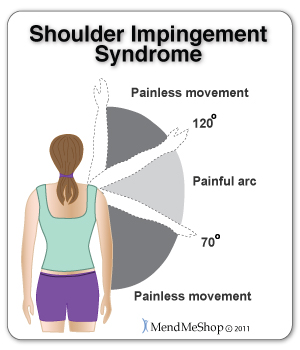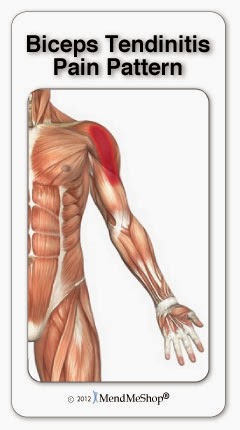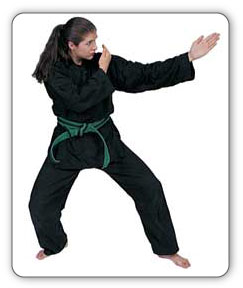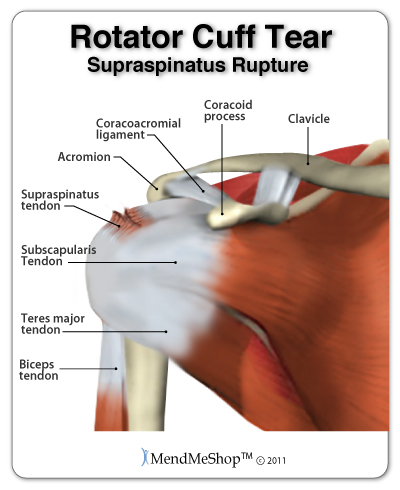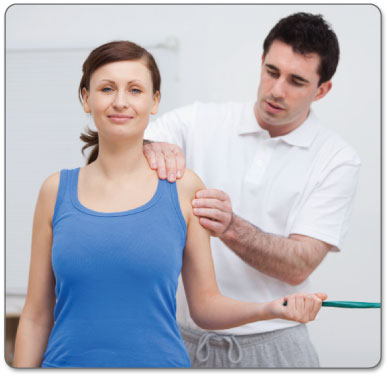|
More Tendon Facts:
Tenosynovitis is a condition affecting the sheath that surrounds a tendon. In many cases, the sheath encounters tearing due to inflammation of the underlying tendon. The majority of tenosynovitis sufferers are female.
A fully ruptured Tendon REQUIRES surgery. It will not heal on its own.
Except for a fully ruptured tendon, Tendonitis can almost always be cured without surgery.
Left untreated, tendonitis can be extremely debilitating and lead to life long complications.
Continually using your Tendon while it is injured will lead to a worse injury.
To Heal as fast as possible use conservative treatment options at home such as: Rest
Use an Ice Pack to Get Swelling Down
Use a TShellz Wrap at Home Once Swelling is Down
Stretch at Home Once Your PT or Doctor Approves
Treat the Injury Well Beyond the Point After the Pain Disappears
|
Biceps Tendonitis
Biceps Tendonitis is also known as Bicipital Tendonitis
Anatomy of the Biceps
The Biceps Brachii (commonly called the biceps) is a muscle located at the front of the upper arm and attaches your arm bone (humerus) to your shoulder. It is the muscle that bumps up when you flex your arm and it functions to rotate your arm from pronation to supination (twist your palm upward), and to bend your elbow and shoulder.
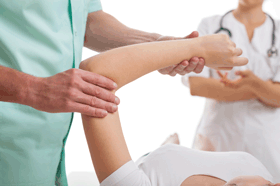 Biceps means 'two heads' in latin and the muscle earns its name because it joins at the shoulder in 2 places with 2 different 'heads', know as the proximal biceps tendons because they are closest to the top of the arm. The short head of the biceps tendon originates at the coracoid process of the scapula (shoulder blade). The long head of the biceps originates just above the glenoid fossa (joint cavitiy) of the scapula (shoulder blade) and runs in front of the head of the humerus along the bicipital groove, like a rope through a pulley. The transverse humeral ligament runs over top of the long head biceps tendon, holding it against the humeral head. The 2 heads of the biceps then merge and go down the length of the upper arm. It attaches at the largest part of the radius (lower arm bone) at the elbow.
Both heads of the biceps muscle are attached to the shoulder bones with their respective tendons. These tendons can become irritated and inflamed from a strain or over use of the tendon. As a result, tendonitis, tenosynovitis or a biceps tendon rupture may occur.
Biceps Tendon Injury
Biceps brachii tendon damage, inflammation, strain, or a tear typically affects the long head tendon of the biceps, as it is much more involved with the biceps group of muscles and tendons. The biceps is a commonly injured area of the body due to the large range of motion and frequent use of the shoulder joint.
Biceps tendinitis, or bicipital tendinitis (also spelled tendonitis), is a painful condition that affects the fibres of the biceps brachii tendon. Tendinitis occurs when the biceps tendon experiences small tears, is irritated, and becomes inflamed. As tendonitis develops, the tendon shealth (covering) can become thicker due to the tough scar tissue that builds up during healing. This thickening makes the tendon less flexible and prone to further injury.
Biceps tendonitis causes pain in your arm and/or shoulder and may lead to more severe problems if left untreated. The tendon and its sheath can become bound together, a condition known as adhesive tenosynovitis, which can severely restrict the range of motion within the arm and shoulder. The walls of the tendon sheath can thicken which prevents the tendon from sliding through the opening that keeps it in place, a condition known as constrictive tenosynovitis. The bicep tendon can rupture, or tear, completely which may require surgery.
Biceps tenosynovitis is a common tendon injury that typically affects older athletes. The synovial sheath (outer covering) of the biceps brachii tendon becomes inflamed and swollen. This limits the biceps tendon's ability to slide through the sheath smoothly and can cause scar tissue to build up between the tendon and its sheath restricting movement even more.
The biceps tendons are strong, cord-like structures that connect the upper end of the biceps muscle to the bones in the shoulder. The biceps tendons and muscle, help you to bend your elbow and rotate your arm. They also keep your shoulder stable and your arm centered in your shoulder socket.
There are two biceps tendons located on the front side of your upper arm and shoulder. The long head biceps tendon attaches to the top of the shoulder socket (glenoid). The short head of the biceps tendon attaches to a bump on the shoulder blade called the coracoid process. On the other end of your bicep there 1 tendon that attaches your muscle to the radius bone at the elbow.
Symptoms of Biceps Tendinitis?
If you are suffering from bicep tendonitis you will have pain in the front of your shoulder and some tenderness / weakness in your bicep muscle. Pain will increase as you lift your arm overhead, raise your arm in a throwing motion, or pull on something with your arm. You may have pain and a deep achy-ness in the shoulder that moves down the front of your arm, and in some cases, radiate down to the hand. Sometimes snapping can be heard or felt in the shoulder.
Pain from biceps tendinitis may worsen at night, especially if you sleep on the arm that has been affected with the biceps tendinitis.
If you have biceps brachii tendonitis or tenosynovitis you may experience:
- Pain and tenderness at the front of the shoulder that may move down the upper arm.
- Pain that increases when lifting your arm out front or above the shoulder.
- Pain that often gets worse at night or upon awakening in the morning.
- Redness, swelling, and a sensation of heat in the area of the biceps tendon.
- Limited range of motion in the shoulder and the elbow.
With bicep tenosynovitis you may also experience:
- A sticking feeling in the upper arm/shoulder.
- A crackling noise (crepitation) in the shoulder when the arm is moved as the tendon tries to move through the sheath.
With a biceps tendon rupture:
- You may hear or feel a snap at the top of the shoulder with sharp pain. When this occurs, pain in the shoulder may quickly disappear as the pull causing strain in the head of the biceps is reduced.
- Bruising midway down the arm to the elbow may be evident.
- A bulge at the bottom of the biceps is usually noticable.
- There will be weakness when you try to lift your arm or bend the elbow.
- If not torn completely, there may only be pain at the front of the shoulder.
Due to the biceps muscle's connection to the shoulder joint, other problems that may occur in conjunction with biceps tendonitis include injuries such as shoulder impingement, shoulder instability, tears in the glenoid labrum that can lead to frozen shoulder, arthritis, and rotator cuff tendon tears.
What's the Difference Between Bicep Tendonitis, Tendinosis and Tenosynovitis?
Tendinosis is basically like tendonitis but it's not caused by an injury. Tendinosis is caused by chronic degeneration (wearing away) of tendon fibers over time. This is a natural thing that happens to our tissue as we age.
Where tendonitis is damage or micro-tearing to your tendon, Tenosynovitis is damage or micro-tearing to the sheath covering your tendon. This sheath is a protective lining for your tendon and is made up of synovium. If this sheath is injured it can also become irritated resulting in similar symptoms as tendonitis (pain, swelling and inflammation).
It's possible for you to have tendonitis / tendinosis AND Tenosynovitis at the same time creating a more complicated bicep tendonitis injury.
Biceps Tendinitis Causes
In the majority of cases, wear and tear of the biceps tendon causes damage. This wear and tear is often due to overuse of the shoulder doing the many overhead activities that we perform in our daily lives, hobbies, and sports. Relevant repetitive actions are common in athletes or workers who use frequent overhead arm movements such as throwing a ball, swinging a racket, swimming, martial arts, lifting weights, dusting high shelves, painting, or completing manual labor tasks. Biceps Tendonitis can also occur because of a sudden, serious injury to the tendon.
Anyone can suffer from biceps tendinitis, but it's most common in adults due to degeneration of tissue as we age. Over time the tendons in the arm will wear down resulting in something called degeneration. This is where the fibers in your tendons will become weaker - it's just a natural process that happens as we age.
Biceps tendinitis often occurs with other shoulder conditions or injuries, usually with damage to the biceps tendons. A fall on an outstretched hand or a direct blow to the shoulder can cause acute tendonitis (tendinitis that comes on quickly) if the biceps tendon is damaged. If left untreated, both types of tendinitis may develop into tenosynovitis or a complete tear (rupture).
Specific causes of biceps tendonitis, tenosynovitis, and tears in the biceps tendon include:
- Sports that involve repetitive throwing, lifting or forceful contact such as swimming, baseball, tennis, gymnastics, and weightlifting.
- A torn transverse humeral ligament. This ligament usually holds the biceps tendon in the bicipital groove at the top of the humerus, but if torn, the tendon can slip out of the groove and become irritated.
- Work that requires repetitive overhead movements such as painting, hammering, and overhead lifting.
- Straining the biceps muscle or tendon due to overuse or unusual use.
- Having an ongoing or previous shoulder injury that may have not healed properly.
- Infection in the shoulder, sometimes following surgery, although this is a less common cause.
Do You Really have Biceps Tendonitis?
Your shoulder and arm connect into one ball-and-socket joint, involving 3 bones, and a large number of muscles, tendons, ligaments, connective tissues and synovial fluid. Biceps tendonitis usually occurs along with other shoulder related problems:
- Biceps tendon tear, then deformity of the arm (a "Popeye" bulge in the upper arm)
- Chronic shoulder instability
- Biceps Tenosynovitis, inflammation of the tendon sheath
- Arthritis of the shoulder joint, Osteoarthritis or Rheumatoid arthritis
- Tendinosis of the biceps tendon, caused by degeneration of the tendon from athletics requiring overhead motion or from the normal aging process
- Rotator cuff tear, a group of 4 tendons located at the shoulder acting as a 'cuff' to connect your humerus bone to the rotator cuff muscles. Acute trauma results from a sudden injury such as falling onto an outstretched arm, which can bruise, strain or tear your rotator cuff tendon(s) or muscle(s) at any age. Excessive force exerted by lifting or pulling something too heavy, pushing off an object vigorously with your arm, or making a forceful and abrupt forward throwing or overhead action, can also severely damage and tear your rotator cuff.
- Tears in the shoulder joint (Slap tear or glenoid labrum tear). There are 3 bones in the shoulder blade (scapula), the collarbone (clavicle), and the upper arm bone (humerus). Injuries to the tissue rim surrounding the shoulder socket(s) can occur from acute trauma or repetitive shoulder motion or injury. Falling on an outstretched arm, a direct blow to the shoulder, a sudden pull (ie. trying to lift a heavy object), or a violent overhead reach (ie. trying to stop a fall or slide) can cause a slap tear or labrum tear injury.
- Shoulder Bursitis is often due to overuse or overhead repetitive actions. It can also be a result of something as simple as an awkward fall or trying to lift something up high with a weakened shoulder. When pressure or friction is too great, excess fluid can build up in the bursa sac causing swelling and inflammation. Moving the shoulder becomes very painful and movement can be difficult. Any actions that put pressure on the inflamed bursa can increase irritation and cause further inflammation and pain. Symptoms of shoulder bursitis are pain, limited range of motion, weakness, difficulties sleeping, swelling and tenderness, and possibly a fever if the bursa is infected (septic shoulder bursitis).
- Calcific tendinitis A chemical reaction with other tissues in the body and calcium builds-up in the tendons. More common condition with women and the age ranges between 30 and 50. This is not a sport / activity related injury. It is known as a natural process than can occur in some people and not in others. The shoulder and rotator cuff are the typical location of calcific tendinitis - it is also know as calcific tendinopathy. Pain and stiffness that often comes back but usually last one to two months.
- Impingement Syndrome happens when the tendons in your shoulder get caught by the bones in your shoulder. Over time if left untreated impingement syndrome can result in shoulder tendonitis, bursitis and can cause tearing in your rotator cuff tendons. Like shoulder tendonitis, impingement syndrome can happen from repeated overhead activity or movement like painting, lifting, swimming and any other overhead sports. There are generally 3 stages in impingement syndrome: Stage 1 (pain, swelling and inflammation in the rotator cuff tendons), Stage 2 (rotator cuff tendonitis) and Stage 3 (tendon tissue catching under your bone resulting in immobility and loss of function in your shoulder). Each stage will generally affect a different age group, which is why this condition is thought to progress over time. Stage 1 usually affects individuals younger than 25 years old, Stage 2 affects individuals between the ages of 25 and 40, and Stage 3 affects individuals 40+ (reference: 1).
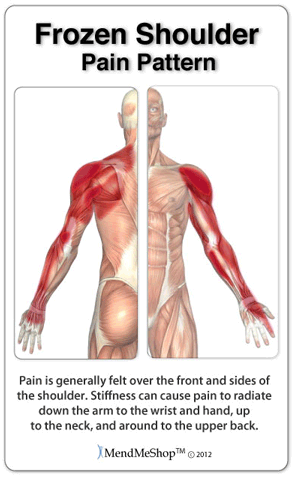 - Frozen shoulder (also known as "adhesive capsulitis") is signified by pain and stiffness in the shoulder joint, limited range of motion and pain while sleeping. This is a condition that commonly occurs in older athletes. Frozen shoulder is 5x more common in people with diabetes, though the reason for this is unknown. It's possible that frozen shoulder will happen as a result of a previous injury (like shoulder tendonitis), but it can also happen for no apparent reason or may be triggered by a mild injury in the shoulder area. There are 3 phases to this condition: "Freezing" (general pain, swelling and inflammation), "Frozen" (stiffness in your shoulder) and "Thawing" (recovery as pain eases and most of the movement returns). This process will take some time to get through, and can sometimes take as long as 2 or more years to complete.
- Diseases that cause inflammation of the shoulder joint lining - like Synovitis, Gout and Pseudo-gout.
Biceps Tendonitis Diagnosis
Visiting your doctor when you have arm pain is always recommended, as there are many possible issues that can happen within the arm and shoulder joint.
To begin with, your doctor will gather a medical history about you and your current condition and symptoms. They will ask about the intensity of your pain, how long your symptoms usually last and the limitations you're experiencing. Details about when it started and whether or not you have ever had treatments for this or a similar condition in the past are very helpful in assessing your shoulder injury.
Your doctor will also look and feel the bones and soft tissue in both your shoulder and arm to find any differences between you injured arm/shoulder and your healthy arm/shoulder. This will help them to feel any abnormalities in and around your shoulder - like mild or severe inflammation, bone deformities, atrophied muscles (muscles that have wasted away due to injury), redness and/or warmth on the skin.
Your doctor might also perform one of the following physical tests;
Speed's test: Your doctor will press down on your arm as you hold it out with your elbow slightly bent and palm up.
Yergason's test: Your doctor will grip your hand and apply pressure on your arm while you bend your elbow 90 degrees (at a right angle).
For both tests pain in a specific area of the shoulder during will let the doctor know that you have biceps tendinitis.
Sometimes, one set of symptoms can result in multiple diagnoses. An X-ray, CT scan, MRI or visual ultrasound is often needed in order to diagnose if the area is out of alignment or the extent of the soft tissue damage.
It's important to have a proper diagnosis from a doctor or some other medical professional to determine the cause of your symptoms. This way the right treatment can be used to treat the condition and relieve your pain.
Conservative Treatment for Biceps (Shoulder) Tendonitis
In most cases, your Doctor will start with non-surgical treatments options. Some of the options your doctor may recommend include drugs or medications like NSAIDs (non-steroidal anti-inflammatory drugs) to manage pain and inflammation. Steroid injections are advised with caution for any type of tendon condition as there is increased risk of tendon rupture.
The good news is that most cases of bicipital tendinitis will heal with simple home conservative treatments and surgery is often not needed. You will find that conservative treatment for tendon strain is very similar to treatments recommended for a muscle strain.
Use a Cold Compress or Ice Pack on the Injury:
- for 24 to 72 hours after your initial injury or when you first notice pain and swelling in your shoulder/arm/elbow to stop tissue damage at the microscopic level, relieve pain, and decrease swelling.
- After exercise, workouts or activity of any kind to reduce risk of worsening your injury.
- Before and after surgery during rehabilitation to control pre and post-surgery pain and swelling.
- Anytime you feel your shoulder/arm has been over-extended, over-worked, twisted, strained or sprained causing pain and swelling.
- Anytime you have swelling, sharp throbbing pain or inflammation in the tendons or muscles in your arm, elbow or shoulder.
- Any other situation where you need to draw the pain and inflammation out of the area.
Use a Shoulder TShellz Wrap® if the affected tendon is in the shoulder area
Use an Elbow TShellz Wrap® is the affected tendon is at the elbow joint:
- After swelling and inflammation have been reduced with cold compression.
- Before exercise or workouts to warm up the tendons in your biceps to prevent re-injury.
- Before and after surgery during rehabilitation to warm up your tissues before exercising or stretching.
- Anytime you feel the tendons in your arm/shoulder have stiffened up, are tight and your mobility is reduced causing you more pain.
- Anytime you have sore or aching tissue in your arm, elbow and/or shoulder.
- Any other situation where you need to increase blood flow to your biceps tendonitis injury to relax your tendon, relieve pain, prevent re-injury and enhance flexibility of your tissue.
We strongly believe that we can help you, and we have thousands of happy clients to back this claim. You are welcome to try our products for a 60 day period.. If you are committed to following the treatments outlined in the product instructions we are very confident that our TShellz Wraps will aid you immensely. If you do not receive the benefits that countless of our other customers have experienced from our products, call us, mail the product back to us and we will provide you with a full product refund.

Our online shop accepts Visa & Mastercard as well as a Paypal Payment option.
We also encourage your to Call Our Office at 1-866-237-9608 (toll free continental NA) where we can answer any questions you have and/or take your order via phone.
Product specialists are available 9:00 am to 5:00 pm Eastern Standard Time Monday to Friday. If any question or concern arises, call us or simply send us an email at any time (we check our emails constantly all throughout the day and night.. even on holidays!). We will respond as soon as possible. North America Toll Free 1-866-237-9608
Outside North America +1-705-532-1671
A Note On OverCompensation
The longer your injury endures, the greater the risk of running into serious overcompensation injuries.
To Stop Re-Injury & Reduce the Risk of a More Serious Overcompensation Injury, You Need to Heal Quickly & Completely!
Anyone in need of rapid recovery and complete healing must consider a comprehensive treatment plan that includes an effective means to minimize swelling and inflammation yet also stimulate healing and tissue elasticity. We have found no better set of tools that can be used at home than this:
What You Definitely Need to Successfully Treat
& Heal Your Bicep Tendonitis Injury at Home:
- A TShellz Wrap to increase Blood-flow to the strained tendon(Circulatory Boost).
- MendMeShop Arnica Pain Cream for temporary relief of pain due to sore muscles and joints.
- An Exercise & Stretching Plan to prevent muscle atrophy and shortened tendons. A proper plan will increase elasticity and strengthen the muscles of the shoulder, arm and elbow.
Conservative treatment tools just like these have been used successfully by thousands of soft tissue injury sufferers - just like you.
We believe the use of TShellz Wraps® for boosting blood flow in the area of application is one of the most under-utilized home treatment options available on the market today. We have client after client that have tried many options out there and have been amazed at how effective and fast the TShellz Wrap treatment can relieve pain and increase localized blood flow in the treatment area.
The TShellz Wraps significantly increase bloodflow to tissue in the treatment area - period. With regular use of the
TShellz Wrap:
- Your pain will be reduced*.
- With increased blood flow, soft tissue in the area will recover at an accelerated rate*.
- Due to increased warmth in soft tissue, the corresponding joint will have a larger range of motion and increased extensibility of collagen tissue*. This should translate into a reduced rate of injury occurrance as soft tissue becomes more flexible.
(*Chapter 9 of "Therapeutic Heat and Cold", 4th edition.
(amazon.com link - Ed. Justus F. Lehmann, M.D., Williams, and Wilkin)
Attach the TShellz Wrap®, plug it in and let the Energy Pad do the work!
Product Advisors are available 9:00 am to 5:00 pm Eastern Standard Time Monday to Friday.
Learn More About Tendon Injuries & TreatmentsI want to learn more about Post-Surgery Recovery I want to learn more about TShellz Wrap® Circulatory Boost I want to learn more about Ice & Heat: Which Is Better For Treatment? I want to learn more about Tendonitis Treatments I want to learn more about Tendonitis Surgery
FREE SHIPPING ON ALL PRODUCTS CURRENTLY ENABLED
60 DAY TRIAL PERIOD
During your recovery, you will probably have to modify and/or eliminate any activities that cause pain or discomfort at the location of your soft tissue injury until the pain and inflammation settle. The more diligent you are with your treatment and rehabilitation, the faster you will see successful results!
|
Tendon Injury Facts:
When the tendon gets inflamed it is known as tendonitis, and when the tendons are chronically overused, it may lead to microscopic tears in the collagen matrix and causes a gradual weakening of the tissues.
Achilles tendonitis is a common injury among runners, as the Achilles tendon is responsible for helping you lift off the ground with each stride.
As computers become ever more important elements of the work place and everyday life, incidents of wrist tendonitis are on the rise.
Oral Medications can mask the pain but do not aid in the healing of tendonitis. Anti-inflammatories and pain killers can mask the pain and indirectly cause tendonitis to worsen.
Ice and Compression treatments are the easiest and most effective treatments for tendonitis.

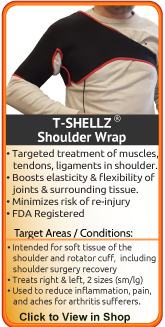




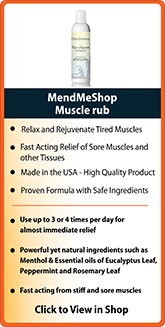

|
